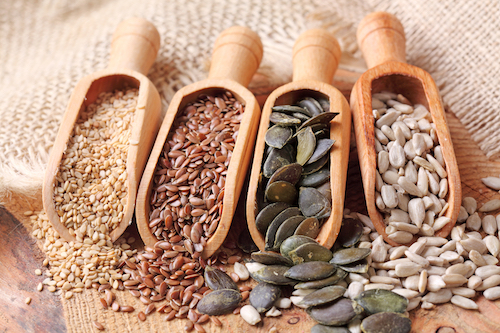
Balance your hormones and sync your cycle with seed cycling
Hormones are a woman’s best friend, helping to control mood, emotions, reproduction, sleep, energy, libido, skin, hair and weight – the list is endless. The actions of hormones are sophisticated and in order for them to work they need to be in perfect balance. Thankfully when things go wrong, we have ways to help, and turning to mother nature is a good place to start.
Seed cycling, also called seed rotation, is a natural method for balancing hormones that has its roots in naturopathic philosophy. In Chinese medicine, yin or yang qualities are assigned to different seeds to match how they nourish different phases of the hormonal cycle.
The method of seed cycling consists of having fresh seeds in your diet at different phases of the female hormone cycle. Different seeds have different nutritional properties and support healthy levels of the right hormones at the right time of the cycle. One of the best things about seed cycling is that it can be beneficial at any stage in a woman’s life.
How does it work?
The female cycle is divided into two main phases, the follicular phase and the luteal phase. Seed cycling can boost estrogen levels during the follicular phase, and progesterone levels during the luteal phase:
- In a typical 28-day cycle, the follicular phase lasts from day 1 to 14 (around the time of ovulation), and this when your body is producing oestrogen. During this phase, we recommend eating flaxseed and pumpkin seeds (1 tablespoon daily), which are rich in phytoestrogens, a gentle, naturally-occurring form of estrogen.
- The luteal phase lasts from day 15 to 28, and during this phase your progesterone levels steadily increase (until your flow starts). It is beneficial to eat sunflower and sesame seeds (1 tablespoon daily) during this time as the high levels of zinc in sesame seeds and vitamin E in sunflower seeds promote progesterone production.
Why seed cycling?
In a perfectly healthy woman, the estrogen/progesterone balance will happen naturally throughout the cycle. However, in today’s world, stress, environmental toxins, food additives, digestive issues, food intolerances, and excessive consumption of alcohol and coffee can disrupt this balance. That is why seed cycling can be such a great hormone-balancing tool. Not only can it easily be added to your diet, it’s gentle on the body, non-invasive, low in cost and delicious too!
Is seed cycling for me?
Seed cycling can help women who experience symptoms of low estrogen or estrogen dominance. Estrogen dominance can be caused by poor estrogen elimination leading to a build-up of an “unhealthy” form of estrogen. In this case, seed rotation can favour a different pathway which reduces accumulation of this “unhealthy” form. Estrogen dominance can also be due to progesterone levels being too low to oppose estrogen. These hormone imbalances may manifest as pre-menstrual syndrome (bloating, mood swings, headaches, sugar cravings), irregular periods, heavy flow, low libido, insomnia, hair loss, breast or ovarian cysts, endometriosis, fibroids, infertility and polycystic ovary syndrome.
How about seed cycling in menopause?
Seed cycling can also be used by peri-menopausal and post-menopausal women by starting on any day and following the same 2-week rotation plan. Since levels of estrogen and progesterone naturally decline during menopause, seed cycling can provide extra support to alleviate symptoms associated with lower hormone levels. In addition, seed cycling has been suggested to minimise the impact of hormone fluctuations, particularly in peri-menopause, by reducing hot flushes and mood swing, and improving energy levels and sleep quality.
Women experiencing amenorrhea (absence of periods) may also benefit from seed cycling by starting the 2-week cycle at any time.
Seeds of wisdom
In addition to balancing your hormones, seeds have many nutritional benefits and are a great addition to a healthy diet and lifestyle. Seeds (and nuts) are packed with vitamins, minerals and antioxidants. They are also a great source of protein, fibre (great at supporting a healthy oestrogen metabolism) and healthy fats. They can reduce sugar cravings, support healthy cholesterol levels and reduce inflammation. You may quickly see an improvement in your energy levels, find your skin is glowing and your hair shining.
Seeds can be easily added to smoothies, yoghurt, porridge, salads, soups, dips such as humus or guacamole, and cooked vegetables. Remember that seeds are best used whole or freshly ground (flaxseeds and sesame seeds, in particular, are best taken ground). Grinding seeds a few days in advance may be convenient; in this case, store them in a sealed jar and use within 7 days.
Seed-cycle mindfully and responsibly
As with any diet or health protocol, balance is key, and seed cycling should not be relied on exclusively for balancing hormones. Seed cycling should be done as part of a comprehensive protocol to regulate your hormones and never as a substitute for a healthy diet and lifestyle. Following a well-balanced diet with a wide variety of foods, looking after your gut health, managing stress and prioritising sleep should be the foundation of any hormone-balancing protocol.
Now that we have shared our seeds of wisdom, are you ready to give it a go? Remember to follow the seed cycling for least 3 months (i.e. 3 cycles) for optimal results.



